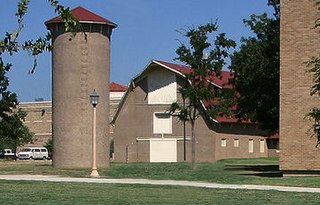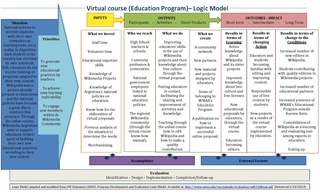Related Research Articles
A teaching method comprises the principles and methods used by teachers to enable student learning. These strategies are determined partly on subject matter to be taught and partly by the nature of the learner. For a particular teaching method to be appropriate and efficient it has to be in relation with the characteristic of the learner and the type of learning it is supposed to bring about. Suggestions are there to design and selection of teaching methods must take into account not only the nature of the subject matter but also how students learn. In today's school the trend is that it encourages much creativity. It is a known fact that human advancement comes through reasoning. This reasoning and original thought enhances creativity.
Media literacy is an expanded conceptualization of literacy that includes the ability to access and analyze media messages as well as create, reflect and take action, using the power of information and communication to make a difference in the world. Media literacy is not restricted to one medium and is understood as a set of competencies that are essential for work, life, and citizenship. Media literacy education is the process used to advance media literacy competencies, and it is intended to promote awareness of media influence and create an active stance towards both consuming and creating media. Media literacy education is part of the curriculum in the United States and some European Union countries, and an interdisciplinary global community of media scholars and educators engages in knowledge sharing through scholarly and professional journals and national membership associations.

Pedagogy, most commonly understood as the approach to teaching, is the theory and practice of learning, and how this process influences, and is influenced by, the social, political and psychological development of learners. Pedagogy, taken as an academic discipline, is the study of how knowledge and skills are imparted in an educational context, and it considers the interactions that take place during learning. Both the theory and practice of pedagogy vary greatly, as they reflect different social, political, and cultural contexts.
The Association of College & Research Libraries defines information literacy as a "set of integrated abilities encompassing the reflective discovery of information, the understanding of how information is produced and valued and the use of information in creating new knowledge and participating ethically in communities of learning".
Blended learning, also known as hybrid learning, technology-mediated instruction, web-enhanced instruction, or mixed-mode instruction, is an approach to education that combines online educational materials and opportunities for interaction online with traditional place-based classroom methods.

Agricultural education is the teaching of agriculture, natural resources, and land management. At higher levels, agricultural education is primarily undertaken to prepare students for employment in the agricultural sector. Classes taught in an agricultural education curriculum may include horticulture, land management, turf grass management, agricultural science, small animal care, machine and shop classes, health and nutrition, livestock management, and biology.

Composition studies is the professional field of writing, research, and instruction, focusing especially on writing at the college level in the United States. The flagship national organization for this field is the Conference on College Composition and Communication.
Place-based education, sometimes called pedagogy of place, place-based learning, experiential education, community-based education, education for sustainability, environmental education or more rarely, service learning, is an educational philosophy. The term was coined in the early 1990s by Laurie Lane-Zucker of The Orion Society and Dr. John Elder of Middlebury College. Orion's early work in the area of place-based education was funded by the Geraldine R. Dodge Foundation. Although educators have used its principles for some time, the approach was developed initially by The Orion Society, a Massachusetts-based nonprofit organization, as well as Professor David Sobel, Project Director at Antioch University New England.
Social learning is learning that takes place at a wider scale than individual or group learning, up to a societal scale, through social interaction between peers. It may or may not lead to a change in attitudes and behaviour.
Scientific literacy or science literacy encompasses written, numerical, and digital literacy as they pertain to understanding science, its methodology, observations, and theories. Scientific literacy is chiefly concerned with an understanding of the scientific method, units and methods of measurement, empiricism and understanding of statistics in particular correlations and qualitative versus quantitative observations and aggregate statistics, as well as a basic understanding of core scientific fields, such as physics, chemistry, biology, ecology, geology and computation.

Agriculture in the Classroom (AITC) is a grassroots program coordinated by the United States Department of Agriculture (USDA) and the National Agriculture in the Classroom Organization. Its goal is to help students gain greater awareness of the role of agriculture in the economy and society, so that they may become citizens who support wise agricultural policies. AITC raises agricultural literacy by helping students understand the farm sources of their food, fabric and flowers.

Education in Mali is considered a fundamental right of Malians. For most of Mali's history, the government split primary education into two cycles which allowed Malian students to take examinations to gain admission to secondary, tertiary, or higher education. Mali has recently seen large increases in school enrollment due to educational reforms.
Multiliteracies is a term coined in the mid-1990s by the New London Group and is an approach to literacy theory and pedagogy. This approach highlights two key aspects of literacy: linguistic diversity, and multimodal forms of linguistic expression and representation. The term was coined in response to two significant changes in globalized environments: the proliferation of diverse modes of communication through new communications technologies such as the internet, multimedia, and digital media, and the existence of growing linguistic and cultural diversity due to increased transnational migration. Multiliteracies as a scholarly approach focuses on the new "literacy" that is developing in response to changes in the way people communicate due to new technologies and new shifts in the usage of language within different cultures.

Indigenous education specifically focuses on teaching Indigenous knowledge, models, methods, and content within formal or non-formal educational systems. The growing recognition and use of Indigenous education methods can be a response to the erosion and loss of Indigenous knowledge through the processes of colonialism, globalization, and modernity.
Second-language acquisition classroom research is an area of research in second-language acquisition concerned with how people learn languages in educational settings. There is a significant overlap between classroom research and language education. Classroom research is empirical, basing its findings on data and statistics wherever possible. It is also more concerned with what the learners do in the classroom than with what the teacher does. Where language teaching methods may only concentrate on the activities the teacher plans for the class, classroom research concentrates on the effect the things the teacher does has on the students.
Feminist pedagogy is a pedagogical framework grounded in feminist theory. It embraces a set of epistemological theories, teaching strategies, approaches to content, classroom practices, and teacher-student relationships. Feminist pedagogy, along with other kinds of progressive and critical pedagogy, considers knowledge to be socially constructed.
Multimodality is the application of multiple literacies within one medium. For example, understanding a televised weather forecast (medium) involves understanding spoken language, written language, weather specific language, geography, and symbols. Multiple literacies or "modes" contribute to an audience's understanding of a composition. Everything from the placement of images to the organization of the content to the method of delivery creates meaning. This is the result of a shift from isolated text being relied on as the primary source of communication, to the image being utilized more frequently in the digital age. Multimodality describes communication practices in terms of the textual, aural, linguistic, spatial, and visual resources used to compose messages.
Critical mathematics pedagogy is an approach to mathematics education that includes a practical and philosophical commitment to liberation. Approaches that involve critical mathematics pedagogy give special attention to the social, political, cultural and economic contexts of oppression, as they can be understood through mathematics. They also analyze the role that mathematics plays in producing and maintaining potentially oppressive social, political, cultural or economic structures. Finally, critical mathematics pedagogy demands that critique is connected to action promoting more just and equitable social, political or economic reform.

The Technological Pedagogical Content Knowledge (TPACK) framework describes the kinds of knowledge required by teachers for the successful integration of technology in teaching. It suggests that teachers need to know about the intersections of technology, pedagogy, and content. Specifically, how these areas of knowledge interact and influence one another in unique and specific contexts. In terms of teaching with technology, it suggests that it impacts not only what we teach but how we teach. This idea was in the zeitgeist in the early 2000s, with scholars working on variations of the idea.

Digital pedagogy is the study and use of contemporary digital technologies in teaching and learning. Digital pedagogy may be applied to online, hybrid, and face-to-face learning environments. Digital pedagogy also has roots in the theory of constructivism.
References
- ↑ National Research Council (1988). Understanding agriculture: New directions for education. Washington: National Academy. pp. 1–2.
- ↑ Frick, M.; Kahler, A.; Miller, W. (1991). "A definition and the concepts of agricultural". Journal of Agricultural Education. 32 (3): 42–57. doi:10.5032/jae.1991.02049.
- ↑ Meischen, D.; Trexler, C.J. (2003). "Rural elementary students' understandings of science and agricultural education benchmarks related to meat and livestock". Journal of Agricultural Education. 44 (1): 43–55. doi:10.5032/jae.2003.01043.
- ↑ Brewster, C. (2012). "Toward a critical agricultural literacy". In Donehower, K.; Hogg, C.; Schell, E. (eds.). Reclaiming the rural: Essays on literacy, rhetoric, and pedagogy. Carbondale, IL: South Illinois University Press. pp. 34–51.
- ↑ Vidgen, Helen A.; Danielle, Gallegos (2014). "Defining food literacy and its components". Appetite. 76 (1): 50–59. doi:10.1016/j.appet.2014.01.010. PMID 24462490. S2CID 29920395.
- ↑ Trexler, Cary, J.; Johnson, Thomas; Heinze, Kirk (2000). "Elementary and middle school teacher ideas about the agri-food system and their evaluation of agri-system stakeholders' suggestions for education". Journal of Agricultural Education. 41 (1): 30–38. CiteSeerX 10.1.1.487.4963 . doi:10.5032/jae.2000.01030.
- ↑ Lineberger, Sarah, E.; Zajicek, Jayne M. (2000). "School gardens: Can a hands-on teaching tool affect students' attitudes and behaviors regarding fruit and vegetables?". HortTechnology. 10 (3): 593–597. doi: 10.21273/HORTTECH.10.3.593 .
- ↑ Hubert, D.; Frank, A.; Igo, C. (2000). "Environmental and agricultural literacy education". Water, Air, & Soil Pollution. 123 (1): 525–532. Bibcode:2000WASP..123..525H. doi:10.1023/a:1005260816483. S2CID 93265119.
- ↑ Zollman, Alan (2012). "Learning for STEM literacy: STEM literacy for learning". School Science and Mathematics. 112 (1): 12–19. doi:10.1111/j.1949-8594.2012.00101.x.
- ↑ Moore, Lori, I.; Odom, Summer, F.; Moore, Kari T. (2013). "What a degree in agricultural leadership really means: Exploring student conceptualizations". Journal of Agricultural Education. 54 (4): 1–12. doi:10.5032/jae.2013.04001.
- ↑ Boyer, W. (2013). "Using interactions between children and companion animals to build skills in self-regulation and emotion regulation". In Jalongo, M. R. (ed.). Teaching compassion: Humane education in early childhood. New York: Springer. pp. 33–47.
- ↑ Wight, R. A. (2013). "The AgroEcological-Educator: Food-based community development". Community Development Journal. 49 (2): 198–213. doi:10.1093/cdj/bst038.
- ↑ Widener, P.; Karides, M. (2014). "Food system literacy". Food, Culture & Society. 17 (4): 665–687. doi:10.2752/175174414x14006746101916. S2CID 142670814.
- ↑ Bowers, C. A. (1997). The culture of denial: Why the environmental movement needs a strategy for reforming universities and public schools. Albany, NY: State University of New York Press.
 This article incorporates public domain material from the Congressional Research Service document: Jasper Womach. "Report for Congress: Agriculture: A Glossary of Terms, Programs, and Laws, 2005 Edition" (PDF).[ dead link ]
This article incorporates public domain material from the Congressional Research Service document: Jasper Womach. "Report for Congress: Agriculture: A Glossary of Terms, Programs, and Laws, 2005 Edition" (PDF).[ dead link ]